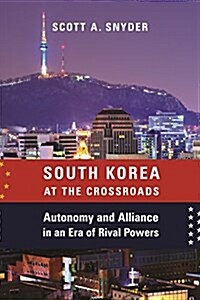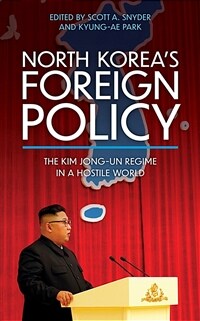
South Korea at the crossroads: autonomy and alliance in an era of rival powers
- 개인저자
- Scott A. Snyder
- 발행사항
- New York : Columbia University Press, 2018
- 형태사항
- 355 p. : 24 cm
- ISBN
- 9780231185486(cloth : alk. paper)
- 청구기호
- 327.51 S668s
- 서지주기
- Includes bibliographical references and index
소장정보
| 위치 | 등록번호 | 청구기호 / 출력 | 상태 | 반납예정일 |
|---|---|---|---|---|
이용 가능 (1) | ||||
| 1자료실 | 00016433 | 대출가능 | - | |
- 등록번호
- 00016433
- 상태/반납예정일
- 대출가능
- -
- 위치/청구기호(출력)
- 1자료실
책 소개
Snyder begins with South Korea’s effort in the 1960s to offset the risk of abandonment by the United States during the Vietnam War and the subsequent crisis in the alliance during the 1970s. A series of shifts in South Korean foreign relations followed: the “Nordpolitik” engagement with the Soviet Union and China at the end of the Cold War; Kim Dae Jung’s “Sunshine Policy,” designed to bring North Korea into the international community; “trustpolitik,” which sought to foster diplomacy with North Korea and Japan; and changes in South Korea’s relationship with the United States. Despite its rise as a leader in international financial, development, and climate-change forums, South Korea will likely still require the commitment of the United States to guarantee its security. Although China is a tempting option, Snyder argues that only the United States is both credible and capable in this role. South Korea remains vulnerable relative to other regional powers in northeast Asia despite its rising profile as a middle power, and it must balance the contradiction of desirable autonomy and necessary alliance.
South Korea at the Crossroads examines fifty years of South Korean foreign policy and offers predictions?and a prescription?for the future. Pairing a historical perspective with a shrewd understanding of today’s political landscape, Scott A. Snyder contends that South Korea’s best strategy remains a robust alliance with the United States.
목차
List of Figures and Tables
Preface
1. South Korea’s Strategic Choices
2. Strategic Choices Under Authoritarian Rule
3. Roh Tae-woo and Kim Young-sam: Nordpolitik and Democratization
4. Kim Dae-jung and the Sunshine Policy
5. Roh Moo-hyun’s Balancer Policy
6. Lee Myung-bak’s Global Korea Policy
7. Park Geun-hye’s Asian Paradox
8. The Paradox of South Korea’s Middle-Power Status
9. Korea Between the United States and China
10. Unification and Korean Strategic Choices
Epilogue: South Korean Strategic Choices and the U.S.?South Korea Alliance
Select Source Documents
1. Mutual Defense Treaty Between the United States and the Republic of Korea, 1953
2. Joint Statement of North and South, 1972
3. Inter-Korean Agreement on Reconciliation, Non-aggression, and Exchanges and Cooperation Between South and North Korea, 1991
4. South-North Joint Declaration, 2000
5. Declaration on the Advancement of South-North Korean Relations, Peace, and Prosperity, 2007
6. Joint Vision for the Alliance of the United States of America and the Republic of Korea, 2009
7. Joint Declaration in Commemoration of the 60th Anniversary of the Alliance Between the Republic of Korea and the United States of America, 2013
Chronology of Important Events in South Korean Strategic History
Notes
Select Bibliography
Index





